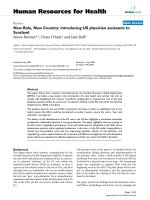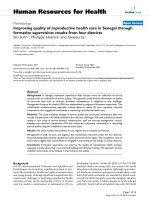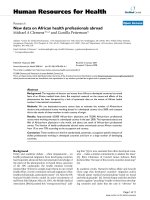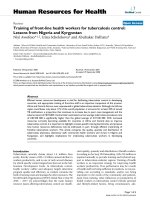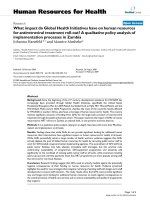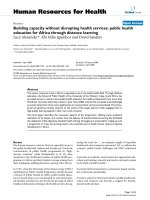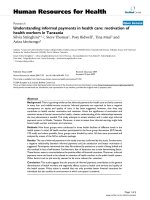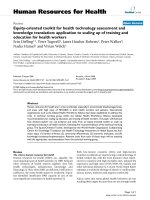báo cáo sinh học:" New data on African health professionals abroad" docx
Bạn đang xem bản rút gọn của tài liệu. Xem và tải ngay bản đầy đủ của tài liệu tại đây (466.49 KB, 11 trang )
BioMed Central
Page 1 of 11
(page number not for citation purposes)
Human Resources for Health
Open Access
Research
New data on African health professionals abroad
Michael A Clemens*
1,2
and Gunilla Pettersson
3
Address:
1
Center for Global Development, 1776 Massachusetts Ave. NW, Suite 301, Washington, DC 20036, USA,
2
Public Policy Institute,
Georgetown University, 3520 Prospect St. NW, 4th Fl., Washington, DC 20007, USA and
3
Department of Economics, University of Sussex,
Brighton, BN1 9RE, UK
Email: Michael A Clemens* - ; Gunilla Pettersson -
* Corresponding author
Abstract
Background: The migration of doctors and nurses from Africa to developed countries has raised
fears of an African medical brain drain. But empirical research on the causes and effects of the
phenomenon has been hampered by a lack of systematic data on the extent of African health
workers' international movements.
Methods: We use destination-country census data to estimate the number of African-born
doctors and professional nurses working abroad in a developed country circa 2000, and compare
this to the stocks of these workers in each country of origin.
Results: Approximately 65,000 African-born physicians and 70,000 African-born professional
nurses were working overseas in a developed country in the year 2000. This represents about one
fifth of African-born physicians in the world, and about one tenth of African-born professional
nurses. The fraction of health professionals abroad varies enormously across African countries,
from 1% to over 70% according to the occupation and country.
Conclusion: These numbers are the first standardized, systematic, occupation-specific measure of
skilled professionals working in developed countries and born in a large number of developing
countries.
Background
Policy and academic debate – often impassioned – on
health professional migration from developing countries
has frequently advanced beyond systematic knowledge of
the extent of the phenomenon. In South Africa, epicenter
of the HIV catastrophe, the health minister recently
claimed that "if there is a single major threat to our overall
health effort, it is the continued outward migration of key
health professionals, particularly nurses" [1]. After the UK
National Health Service ended its active recruitment of
staff from Sub-Saharan Africa in 2001, the British Medical
Association (BMA) praised this "strong moral lead," add-
ing that "[i]t is now essential that other developed coun-
tries make a similar commitment to address the issue"
[2]. BMA Chairman of Council James Johnson flatly
declared that "the rape of the poorest countries must stop"
[3].
In academic circles, Harvard's Sabina Alkire and Lincoln
Chen urge that developed countries' migration policy
"should adopt 'medical exceptionalism' based on moral
and ethical grounds" [4]. Devesh Kapur and John McHale
caution against "poaching" health workers from develop-
ing countries and claim that the case is "obvious" for
Published: 10 January 2008
Human Resources for Health 2008, 6:1 doi:10.1186/1478-4491-6-1
Received: 31 January 2007
Accepted: 10 January 2008
This article is available from: />© 2008 Clemens and Pettersson; licensee BioMed Central Ltd.
This is an Open Access article distributed under the terms of the Creative Commons Attribution License ( />),
which permits unrestricted use, distribution, and reproduction in any medium, provided the original work is properly cited.
Human Resources for Health 2008, 6:1 />Page 2 of 11
(page number not for citation purposes)
"restraint" in the recruitment of doctors and nurses [5].
Philip Martin, Manolo Abella, and Christiane Kuptsch
assert that South Africa is "suffering" from a "brain drain"
of doctors and nurses and decry a fiscal impact over $1 bil-
lion [6].
Some of the above statements were carefully researched
using available information. But they were based
(through no fault of the authors) on the available incom-
plete and problematic measures of the extent of health
professional migration because systematic data on inter-
national flows of African health workers have simply been
absent. Untested hypotheses abound.
The simple reason for this is that no agency collects stand-
ardized data on international flows of people disaggre-
gated by occupation. Each scholar who approaches the
issue of African health professional migration is thus
obliged to collect data anew. Amy Hagopian et al. use pro-
fessional association data to count the number of African-
trained physicians from nine sending countries practicing
in two receiving countries (the US and Canada) [7]. Fit-
zhugh Mullan reports the number of physicians trained in
eight African countries (and in Sub-Saharan Africa in the
aggregate) practicing in four Anglophone destination
countries [8]. The World Health Organization lists data
on African-trained doctors and nurses working in seven or
eight destination countries, covering 10 sending countries
for doctors and 19 for nurses [9]. In a more ambitious
effort, Docquier and Bhargava report the number of 'Afri-
can' physicians from each of all the African sending coun-
tries practicing in 16 receiving countries each year from
1991 to 2004 – where 'African' is defined differently
according to each receiving country [10].
Limitations of other investigations
Each of these valuable datasets, while useful for certain
research questions, has important characteristics that
limit its application to other questions. First, three of
these studies count only physicians; they omit nurses and
all other types of health professionals, who are of great
importance to African health systems and who constitute
the majority of the health professional diaspora from Sub-
Saharan Africa. Second, the studies of Hagopian et al.,
Mullan, and WHO only report a limited number of send-
ing and receiving countries, giving a poor idea of total
flows – especially for non-Anglophone African countries.
Third, the Hagopian et al., Mullan, and WHO data focus
exclusively – and Docquier and Bhargava primarily – on
African-trained physicians as the principal measure of phy-
sicians' departure from Africa. This approach would lead
to decent statistics for a study of, say, the fiscal conse-
quences of physician emigration; the vast majority of Afri-
can-trained doctors are trained with public funds. (It
would be problematic even for this purpose, however,
since a portion of African doctors trained abroad do so
using scholarships funded by their home governments.) A
statistic measuring diaspora size based on country of birth
would be a poor indicator indeed of the fiscal conse-
quences of emigration. But a narrow focus on country of
training would not be appropriate for other studies – such
as an investigation of the effects of physician emigration
on health system staffing, health care availability, or
health outcomes in the countries of origin. We explain
below.
To see this, note that 12 of the 53 countries in Africa (and
11 of 48 Sub-Saharan countries) do not have a medical
school accredited by the Foundation for Advancement of
International Medical Education and Research (FAIMER)
[11]. A medical degree from a FAIMER-accredited school
is a prerequisite to licensure in major receiving countries
such as the United States [12], and related but effectively
similar restrictions apply in Australia and Canada. This
means that, properly measured, an indicator of physician
'drain' based strictly on country of training would define
about a quarter of Sub-Saharan Africa to have lost zero
physicians to emigration. It is certain, however, that phy-
sicians would have left most or all of those countries to
some degree at some point, with possible consequences
for staffing, the availability of care or health outcomes. For
related reasons, a country-of-training based measure
would artificially define nurse emigration from most
Francophone African countries to be extremely small,
since French law currently mandates that only graduates
from French nursing schools may practice as professional
nurses in France. Home-trained nurses who leave must
therefore train again, in France, in order to appear in the
data as practicing nurses in France – so they become for-
eign-trained nurses. Beyond this, a country-of-training
measure for either doctors or nurses would give an odd
accounting even for countries that do have accredited
schools but many of whose nationals nevertheless train in
other African countries. For instance: Doctors in the UK
who were born in Zambia and Zimbabwe, but who
trained in South Africa, would contribute exclusively to
the South African 'brain drain' – a classification that might
be sensible for some research questions, but not others.
Fourth, the Docquier and Bhargava data take the very
problematic step of mixing different and highly conflict-
ing measures of what constitutes an African physician
abroad. 'African' physicians are counted in some destina-
tion countries by their country of birth (e.g. Belgium), in
others by their country of citizenship (e.g. Portugal), and
in others by their country of training (e.g. France). This
fact renders the meaning of the blended database
extremely vague. To give one example, the French Ordre
National des Médecins reports that in 1999 there were
Human Resources for Health 2008, 6:1 />Page 3 of 11
(page number not for citation purposes)
238 physicians in France who were citizens of Sub-Saha-
ran African countries, but the French census of 1999
reports 4,203 physicians in France who were born in Sub-
Saharan Africa – a difference of 1,766%! To make another
comparison, in 2001 the Canadian Medical Association
reports 190 physicians in Canada trained in Egypt, but the
Canadian census of the same year shows 750 Egyptian-
born physicians working in Canada (a 395% difference).
Such discrepancies are the rule, not the exception. Differ-
ences of this magnitude suggest that mixing these differ-
ent classifications can destroy the ability of the resulting
number to measure anything at all. In empirical studies of
emigrants and diasporas it is imperative to choose a single
definition and retain it.
Fifth, there are limits to the coverage of the Docquier and
Bhargava data in time and space. They report panel data
on 14 years of annual flows of physicians out of Africa,
but these are calculated based on 14 years of annual stock
data for only five of the 16 destination countries they
study. In the other 11 receiving countries the flows are
interpolated from three or fewer annual observations (in
10 of them, 2 or fewer observations). For the large major-
ity of the receiving countries, then, the annual flows are
broad interpolations. The result is a database that is a
blend of cross section and time series, with an unknown
degree of measurement error in either dimension. Finally,
the dataset omits destination countries that are very
important for certain African sending countries, destina-
tions like Spain and South Africa.
The present study seeks to create a systematic, standard-
ized snapshot of the stock of African-born physicians and
professional nurses living and working in developed
countries. It improves on earlier work by including profes-
sional nurses; by maintaining a single, consistent defini-
tion of 'African'; by including all the major destination
countries; by covering every African sending country; and
by providing information on country of birth rather than
country of training, a more useful measure for certain
research questions.
Crucially, the numbers presented here do not represent the
number of Africans who became health professionals in
Africa and subsequently departed Africa. They only and
exclusively represent the numbers of African people who
have two traits: 1) they work outside Africa and 2) they
work as health professionals. Only a subset of these peo-
ple became health professionals in Africa and subse-
quently moved. If the latter is the population of interest,
however, then for the reasons discussed above, simply
counting up health professionals outside Africa who were
trained in Africa (as is often done in the literature) is not
an adequate measure either. As we have explained, this
would severely undercount physician 'drain' from one
quarter of sub-Saharan African countries, as well as nurse
'drain' from all of Francophone Africa. The simple fact is
that no single, one-size-fits-all measure of health profes-
sional 'drain' exists. A statistic describing the size of the
African health professional diaspora based on country of
birth is not a measure of 'drain', but captures interesting
information relevant to research questions about 'drain';
the same is true of a statistic focusing on country of train-
ing.
Methods
In late 2005 we contacted the census bureaus of the nine
most important destination countries for African health
professional emigrants to obtain estimates of the number
of African-born doctors and nurses living in each destina-
tion country at the time of the most recent census.
What is an 'African' health professional?
There is, of course, no single statistic that captures the
extent of "African health worker emigration". One can
interpret each component of the phrase in multiple ways.
Is an "African" someone resident in Africa, someone born
in Africa, someone whose ancestors for several genera-
tions were born in Africa, someone trained in Africa, or
someone who holds African citizenship? Does "Africa"
include North Africa and all of South Africa? Is a "health
worker" someone who was trained as such or someone
who currently works in the health sector? How long must
one stay outside the country for that movement to be
"emigration"?
This database takes one of many possible valid stances on
these questions. Here, we classify "Africans" by country of
birth; we include the entire African continent; we count as
doctors and nurses only those currently employed as doc-
tors and nurses; we include only developed countries as
destinations; and we count those who were residing in the
receiving countries on a sufficiently permanent basis circa
2000 to be included in that country's most recent census.
All previous databases and this one share limitation that
they are based on census or professional society data and
thus record each individual's occupation as the job that
the person performs currently. An African trained as a
nurse who now works abroad outside the health sector is
therefore not counted. But to the extent that the tendency
for emigrant health professionals to leave the health sec-
tor does not differ markedly by country of origin, even
numbers that do not account for this phenomenon still
give a good indicator of relative emigration across sending
countries. In other words, a certain number of emigrated
Senegalese nurses are not counted because they no longer
work as nurses. But there is no a priori reason to think this
tendency stronger (nor thus that undercounting is greater)
for Senegalese nurses than for Malawian nurses. An addi-
Human Resources for Health 2008, 6:1 />Page 4 of 11
(page number not for citation purposes)
tional reason the data are informative despite the absence
of those who leave the health profession in the destina-
tion countries is that some research questions will focus
primarily on those who remain in the health field. A key
question for policy research is whether or not developed
countries are luring specifically health workers from poor
countries to fill developed-country positions, and the
incentive systems they create to do so only function to the
extent that the immigrants remain in health care.
The case of Mozambique aptly illustrates the sensitivity of
data like these to different assumptions. The Mozambique
Medical Association estimates, in a personal communica-
tion to the authors, that only around 5% of Mozambican
physicians work abroad. Destination-country census data
show that about 75% of people born in Mozambique
who now work as physicians do not live in Mozambique.
The main cause of this disparity is the fact that many of
those physicians are of European ancestry and departed in
the mass exodus of Portuguese colonists around inde-
pendence in 1975. But it is not at all obvious that count-
ing whites results in a poor measure of human capital loss.
In South Africa white health professionals today play an
important role in educating a new generation of black
health professionals. It is true that Mozambican-born
physicians in the white colonist class were providing most
of their health care to urban elites in the colonial era
rather than to rural blacks, but the same could be said of
many black physicians in today's independent African
states. We take country of birth as a useful measure of
"African-ness" though we recognize it is not germane to
all research questions. To restate this point, 1) white Afri-
can colonial doctors have made and do make some con-
tribution to health conditions for black Africans, and 2)
many black African doctors have only a limited impact on
health conditions for the mass of black Africans, for exam-
ple because many focus their practices on elites who live
in urban areas. It is not at all clear, therefore that a meas-
ure of the African health professional diaspora restricted
only to certain ethnic groups is a superior measure for all
or even most research questions.
Nine destination countries proxy for the world
We also assume that we have a good estimate of how
many African health professionals live outside each send-
ing country simply by counting how many live in the nine
most important destination countries. Those countries are
the United Kingdom, United States, France, Australia,
Canada, Portugal, Belgium, Spain, and South Africa. In
choosing this list we sought a balance between coverage
and the time and expense of additional data collection.
The primary reason that we take these countries as suffi-
cient for most purposes to capture health professional
emigration from Africa is that the first eight receiving
countries alone account for 94.2% of all African-born,
university-educated people residing in any OECD country
in 2000. Our experience comparing the migration pat-
terns of African health professionals to those of other
types of well-educated migrants suggests that the propor-
tion of total African health professional emigrants is sim-
ilar to this value. We add a ninth country, South Africa,
because we take it to be the most important non-OECD
receiving country for African health professionals.
It is of course possible that another non-OECD country,
such as Saudi Arabia, is important for some countries, or
that health professionals differ greatly in their migration
patterns from other skilled professionals. But survey data
from African health professionals considering emigration
suggest that neither of these is the case. Between 2001 and
2002, Magda Awases et al. of the World Health Organiza-
tion interviewed 2,382 doctors, nurses, and other health
professionals in six African countries [13]. Each person
declaring an intention to emigrate was asked his or her
favored destination. The fraction of these in each country
who gave one of our nine destination countries was
89.3% in Cameroon, 91.8% in Senegal, and 94.6% in
South Africa. A small percentage of respondents in Zimba-
bwe mentioned Botswana and New Zealand as destina-
tions but the vast majority mentioned one of our nine
receiving countries. Respondents from Ghana and
Uganda did not mention any countries outside Africa
besides the US and UK, and these two destinations plus
South Africa accounted for the vast majority of favored
destinations in both cases.
Martha Johanna Oosthuizen surveyed in 2002 the favored
destination countries of a sample of Registered Nurses in
South Africa who had just finished their training if they
were to work outside South Africa [14]. Of these, 24%
mentioned countries outside Africa not included in the
nine considered here: Ireland (2%), New Zealand (4%),
and Saudi Arabia (18%). An additional 11% mentioned
unspecified "other countries in Europe and Africa", a sub-
set of which may be included in the nine countries consid-
ered here. These results are somewhat difficult to interpret
since, of the 105 people who answered the survey, only 85
stated that they would ever consider working outside the
country while 91 gave a favored destination if they were to
work outside the country. The 105 respondents were self-
selected from a pool of 500 nurses initially contacted, so
nonresponse bias in these numbers is a real possibility.
Note also that direct recruitment of nurses by Saudi Arabia
in South Africa is a very recent phenomenon, meaning
that the proportion of emigrating South African Regis-
tered Nurses who went to Saudi Arabia before the year
2000 is certainly much lower than 18%.
Human Resources for Health 2008, 6:1 />Page 5 of 11
(page number not for citation purposes)
Fraction of African-born physicians residing and working abroad circa 2000Figure 1
Fraction of African-born physicians residing and working abroad circa 2000.
0.0 0.2 0.4 0.6 0.8 1.0
Egypt
Libya
Niger
Congo, Dem.
Guinea
Botswana
Mauritania
Sudan
Nigeria
Côte d'Ivoire
Gabon
Burkina Faso
South Africa
Chad
Mali
Djibouti
Swaziland
Seychelles
Ethiopia
Morocco
Comoros
Somalia
Tunisia
Lesotho
Benin
Eritrea
Burundi
Madagascar
Togo
Central Afr. Rep.
Sierra Leone
Uganda
Rwanda
Algeria
Namibia
Cameroon
Mauritius
Kenya
Cape Verde
Zimbabwe
Senegal
Tanzania
Congo, Rep.
Gambia
Ghana
Zambia
Malawi
São Tome & P.
Equatorial Guinea
Liberia
Angola
Guinea-Bissau
Mozambique
Fraction of physicians abroad, 2000
Human Resources for Health 2008, 6:1 />Page 6 of 11
(page number not for citation purposes)
Fraction of African-born professional nurses residing and working abroad circa 2000Figure 2
Fraction of African-born professional nurses residing and working abroad circa 2000.
0.0 0.2 0.4 0.6 0.8 1.0
Egypt
Sudan
Djibouti
Libya
Botswana
Burkina Faso
Niger
Lesotho
Swaziland
Tanzania
South Africa
Tunisia
Namibia
Gabon
Guinea
Côte d'Ivoire
Mauritania
Kenya
Algeria
Zambia
Somalia
Uganda
Chad
Nigeria
Congo, Rep.
Congo, Dem.
Angola
Benin
Rwanda
Morocco
Mali
Malawi
Ethiopia
Mozambique
Cameroon
Togo
Comoros
Ghana
Zimbabwe
Guinea-Bissau
Central Afr. Rep.
Senegal
Madagascar
Seychelles
Equatorial Guinea
Eritrea
Cape Verde
São Tome & P.
Sierra Leone
Mauritius
Gambia
Burundi
Liberia
Fraction of professional nurses abroad, 2000
Human Resources for Health 2008, 6:1 />Page 7 of 11
(page number not for citation purposes)
Table 1: Physicians born in Africa appearing in census of nine receiving countries circa 2000
Receiving country Total abroad Frac.*
Sending country Domestic GBR USA FRA CAN AUS PRT ESP BEL ZAF
Algeria 13,639 45 5010,59410 0 26099 0 10,860 44%
Angola 881 16 0 5 25 0 2,006 14 5 31 2,102 70%
Benin 405 0 4206000113 0 224 36%
Botswana 530 2810 00300126 68 11%
Burkina Faso 314 0 07700001 0 78 20%
Burundi 230 5 0531030155 9 136 37%
Cameroon 1,007 49 170 332 20 0 0 4 267 3 845 46%
Cape Verde 202 015100018600 0 211 51%
Cent. Afr. Rep. 120 0 07900215 0 87 42%
Chad 248 0 06900001 0 70 22%
Comoros 50 0 02000001 3 24 32%
Congo, DR 5,647 37 90 139 35 0 42 4 107 98 552 9%
Congo, Rep. 670 11 15 468 0 0 49 4 65 135 747 53%
Cote d'Ivoire 1,763 01026200018 3 284 14%
Djibouti 86 0 02500001 0 26 23%
Egypt 143,555 1,465 3,830 471 750 535 1 17 31 19 7,119 5%
Eq. Guinea 47 0040017600 81 63%
Eritrea 173 1855 0205000 0 98 36%
Ethiopia 1,310 6542016309112 9 553 30%
Gabon 368 0 06100004 0 65 15%
Gambia 40 1630 000000 0 46 53%
Ghana 1,294 5908501695004282 1,639 56%
Guinea 898 3 15 6910 0 011 7 0 115 11%
Guinea-Bissau 103 015750016001 0 251 71%
Kenya 3,855 2,733 865 0 180 110 1 4 1 81 3,975 51%
Lesotho
114 8 0 00000049 57 33%
Liberia 73 10105 500051 0 126 63%
Libya 6,371 34912020755097 0 585 8%
Madagascar 1,428 63087800006 0 920 39%
Malawi 200 19140 001021148 293 59%
Mali 529 01513800004 0 157 23%
Mauritania 333 0102800041 0 43 11%
Mauritius 960 294 35 307 110 36 1 0 20 19 822 46%
Morocco 14,293 33 225 5,113 70 4 9 833 213 6 6,506 31%
Mozambique 435 16 20 0 10 3 1,218 4 2 61 1,334 75%
Namibia 466 3715 0309000291 382 45%
Niger 386 0102300013 0 37 9%
Nigeria 30,885 1,997 2,510 29 120 0 1 13 6 180 4,856 14%
Rwanda 155 4 25 8 0 0 1 0 70 10 118 43%
Sao Tome & P. 63 0000096100 97 61%
Senegal 640 0406031001912 3 678 51%
Seychelles 120 29 0 4103000 4 50 29%
Sierra Leone 338 118115 900003 4 249 42%
Somalia 310 5370 0253000 0 151 33%
South Africa 27,551 3,509 1,950 16 1,545 1,111 61 5 0 -834** 7,363 21%
Sudan 4,973 6066517154001410 758 13%
Swaziland 133 4 4 00010044 53 28%
Tanzania 1,264 743 270 4 240 54 1 1 3 40 1,356 52%
Togo 265 01016800002 0 180 40%
Tunisia 6,459 16 30 3,072 10 0 0 4 60 0 3,192 33%
Uganda 2,429
1,136 290 1 165 61 1 1 3 179 1,837 43%
Zambia 670 465130 04039 3 0 3203 883 57%
Human Resources for Health 2008, 6:1 />Page 8 of 11
(page number not for citation purposes)
Both in the surveys of Awases et al. and of Oosthuizen a
small fraction of emigrating African health professionals
reveal the intent to work in another African country, a
flow which is not captured by the data presented here and
which represents a small discrepancy between these num-
bers and true emigration to all other countries. It is
smaller still when one considers reciprocal flows: A small
number of emigrating Nigerian physicians go to work in
Ghana, but a small number of emigrating Ghanaian phy-
sicians go to work in Nigeria. Counting each as an addi-
tional loss would ignore the fact that for intra-Africa
movements, one country's loss is another's gain. And this
discrepancy, to the extent that it is small and largely inde-
pendent of country characteristics, contributes primarily
white noise to the data here rather than any bias that
would affect the analysis. In sum, the true number of
health professionals working abroad may exceed the
number working in the nine destination countries
focused on here by an amount on the order of 5–10%.
There is little reason to think that this discrepancy is sys-
tematic across countries, so the indicator remains a good
estimate of the relative degree of health professional emi-
gration across countries.
Results
Table 1 presents the number of African-born physicians
residing in the nine principal destination countries circa
2000, and Table 2 presents the numbers for professional
nurses. Combined with statistics for the number of physi-
cians and professional nurses who live and work in each
African country, this allows us to estimate – in the final
column of each table – the fraction of total doctors and
nurses born in each African country who live abroad. Fig-
ure 1 presents this fraction graphically for physicians from
all African countries, and Figure 2 does the same for
nurses. Note well that the numbers of doctors and nurses
working in each African country includes those of all
countries of birth.
Approximately 65,000 African-born physicians and
70,000 African-born professional nurses were working
overseas in a developed country in the year 2000. This rep-
resents about one fifth of African-born physicians in the
world, and about one tenth of African-born professional
nurses. The fraction of health professionals abroad varies
enormously across African countries, from 1% to over
70% according to the occupation and country.
Discussion
The purpose of this note is to describe and disseminate the
data rather than engage in extensive analysis. Several fea-
tures of the data nevertheless leap out of the figures. The
first is the extreme size of the health professional
diaspora, for some countries, relative to the domestic
workforce. For every Liberian physician working in Libe-
ria, about two live abroad in developed countries; for
every Gambian professional nurse working in the Gam-
bia, likewise about two live in a developed country over-
seas. Also notable in the figures is the extreme variation of
these statistics across the continent; Niger has a tiny phy-
sician diaspora; Ghana's is enormous.
Figure 1 also suggests a relationship between the loss of
professionals and economic and political stability.
Angola, Congo-Brazzaville, Guinea-Bissau, Liberia,
Mozambique, Rwanda, and Sierra Leone all experienced
civil war in the 1990s and all had lost more than 40% of
their physicians by 2000. Kenya, Tanzania, and Zimba-
bwe all experienced decades of economic stagnation in
the late 20th century and by its end, each had lost more
than half of its physicians. Countries with greater stability
and prosperity – Botswana, South Africa, and pre-collapse
Côte d'Ivoire – managed to keep their doctors. It further
appears that physicians may not leave countries too desti-
tute to educate large numbers of doctors with the financial
capital or connections abroad that facilitate emigration –
such as Congo-Kinshasa, Niger, and pre-pipeline Chad.
All three of these are among the poorest countries on
earth, are not the site of any of Africa's strongest medical
schools, and have very low physician emigration rates.
Large countries (Nigeria, South Africa) appear better at
generating domestic opportunities for health profession-
als. Doctors from Francophone African countries may face
language barriers or other impediments in the destination
countries with the most opportunities for foreign doctors.
Zimbabwe 1,530 553235 0559712 1 6643 1,602 51%
Africa 280,808 15,258 12,813 23,494 3,715 2,140 3,859 1,096 1,107 1,459 64,941 19%
Sub-Saharan 96,405 13,350 8,558 4,199 2,800 1,596 3,847 173 696 1,434 36,653 28%
Sources: See Acknowledgements. African sending countries show country of birth as recorded in the receiving-country census. Receiving countries
show country of residence at the time of the last census (France [FRA] 1999; United States [USA] 2000; Australia [AUS], Belgium [BEL], Canada
[CAN], Portugal [PRT], South Africa [ZAF], Spain [ESP], and United Kingdom [GBR] 2001). The copyright to some of the data in this table is
retained by the source agency; see appendix for details before reproducing these data elsewhere. All data used here with written permission.
*Gives the number of professionals abroad as a fraction of total professionals (domestic + abroad). **There are 834 physicians born in one of the
other eight receiving countries who appear in the 2001 census of South Africa. This negative number thus represents a "netting out" term.
The full contents of this table are available in an Excel workbook from the Center for Global Development website [17].
Table 1: Physicians born in Africa appearing in census of nine receiving countries circa 2000 (Continued)
Human Resources for Health 2008, 6:1 />Page 9 of 11
(page number not for citation purposes)
Table 2: Professional nurses born in Africa appearing in census of nine receiving countries circa 2000
Receiving country Total abroad Frac.*
Sending country Domestic GBR USA FRA CAN AUS PRT ESP BEL ZAF
Algeria 83,022 37 138 7,953 40 6 1 26 44 0 8,245 9%
Angola 13,135 22 135 12 10 4 1,639 8 11 0 1,841 12%
Benin 1,315 4 28 155 0 0 0 0 0 0 187 12%
Botswana 3,556 47 28 0 0 0 0 0 0 5 80 2%
Burkina Faso 3,097 0 14 50 0 0 0 1 11 0 76 2%
Burundi 381014 12500083 0 13478%
Cameroon 4,998 118 664 343 0 0 0 5 33 0 1,163 19%
Cape Verde 355 091250012800 0 24441%
Cent. Afr. Rep. 300 3 6 85 0 0 0 0 6 0 99 25%
Chad 1,054 0 21 110 0 0 0 0 0 0 131 11%
Comoros 231 0 6 64 0 0 0 0 0 0 70 23%
Congo, DR 16,969 44 207 206 50 0 9 4 1,761 7 2,288 12%
Congo, Rep. 4,933 28 114 369 0 0 14 4 122 9 660 12%
Cote d'Ivoire 7,233 0 185 302 0 0 0 0 22 0 509 7%
Djibouti 424 0 0 9 0 0 0 0 0 0 9 2%
Egypt 187,017 108 661 89 45 87 0 2 0 0 992 1%
Eq. Guinea 162 0 0 0 0 0 0 98 0 0 98 38%
Eritrea 811 27 384 0 75 11 0 0 0 0 497 38%
Ethiopia 5,342 61 888 16 75 37 0 0 0 0 1,077 17%
Gabon 1,554 0149300000 0 1076%
Gambia 14457221 400000 0 28266%
Ghana 14,972 2,381 2,101 1 275 0 0 2 0 6 4,766 24%
Guinea 3,847 0 171 53 10 0 0 27 6 0 267 6%
Guinea-Bissau 799 5 0 45 0 0 212 0 0 0 262 25%
Kenya 26,267 1,336 765 4 135 110 0 0 0 22 2,372 8%
Lesotho 1,2665600000025 363%
Liberia 185 28 773 5 0 0 0 1 0 0 807 81%
Libya 17,779 72 299 1 10 7 0 2 0 0 391 2%
Madagascar 3,088 4 43 1,096 10 0 1 1 17 0 1,171 28%
Malawi 1,871 171 171 0 10 14 0 0 0 11 377 17%
Mali 1,501 0 57 208 0 0 0 0 0 0 265 15%
Mauritania 1,580 0 21 94 0 0 0 2 0 0 117 7%
Mauritius 2,629 4,042 107 86 75 195 1 0 22 3 4,531 63%
Morocco 29,462 47 276 3,707 60 4 5 560 517 0 5,176 15%
Mozambique 3,664 12 64 0 10 0 748 2 6 11 853 19%
Namibia 2,654 18 6 0 0 4 1 0 6 118 152 5%
Niger 2,668 0 28 38 0 0 0 0 0 0 66 2%
Nigeria 94,747 3,415 8,954 24 160 0 0 8 6 12 12,579 12%
Rwanda 1,80513852420311144 0 29214%
Sao Tome & P. 172 0 0 8 0 0 141 0 0 0 149 46%
Senegal 1,887 3 102 584 0 0 0 0 6 0 695 27%
Seychelles 422 80 28 8 30 29 0 0 0 0 175 29%
Sierra Leone 1,524 747 696 4 10 0 0 0 0 0 1,457 49%
Somalia 1,486 76 47 8 30 3 0 0 0 0 164 10%
South Africa 90,986 2,884 877 20 275 955 58 3 33 -261** 4,844 5%
Sudan 26,730428512207000 0 1661%
Swaziland 3,345 21 36 0 10 4 0 0 0 25 96 3%
Tanzania 26,023 446 228 0 240 32 2 1 0 4 953 4%
Togo 782 10 36 140 0 0 0 0 0 0 186 19%
Tunisia 26,389 11 64 1,365 20 0 0 1 17 0 1,478 5%
Uganda 9,851 714 291 0 75 29 0 1 0 12 1,122 10%
Zambia 10,987 664 299 0 25 68 2 0 0 52 1,110 9%
Human Resources for Health 2008, 6:1 />Page 10 of 11
(page number not for citation purposes)
These are simple correlations; establishing causal relation-
ships awaits more systematic analysis of these numbers.
It is important to point out that most publicly released
custom tabulations from census data either contain small
random perturbations or are scaled up from a random
sample of the full census database using sampling
weights, both of which seek to protect the privacy of indi-
vidual census respondents. While the size of these altera-
tions makes them immaterial to the analysis in this paper,
it should be borne in mind that 1) the numbers in Tables
1 and 2 are not an exact representation of the full census
results and 2) a separately-prepared custom extract of pre-
cisely the same variables from the same census may yield
slightly different numbers.
Conclusion
Researchers performing quantitative analysis of the effects
of international trade on development can purchase
detailed bilateral trade statistics from the International
Monetary Fund, disaggregated by product and service with
great detail. Those studying international investment
flows have ready access to bilateral data from the World
Bank and the United Nations disaggregated by financial
instrument. But there exists no comprehensive and sys-
tematic bilateral database of the international flows of
people for all countries, much less one that provides
details about the migrants such as their occupation. All
developed countries collect occupation-specific data on
people who arrive in the country but most do not do so
for people who depart the country, making high-fre-
quency occupation-specific data on bilateral gross migra-
tion flows impossible to compile.
Until such a database exists, quantitative study of this cru-
cial aspect of globalization will be impeded. Researchers
will face the labor-intensive task of compiling data anew
for each investigation. We are currently using the numbers
reported here in concert with other data to perform the
first systematic quantitative analysis of the effects of
health professional emigration on health system staffing
and health care availability in Africa, the first systematic
calculation of return-migration rates for African profes-
sionals, and the first systematic calculation of the net fiscal
impact of African health professional emigration. These
are the first papers in a large-scale research initiative on
the effects of developed-country immigration policy on
poor countries.
Competing interests
The author(s) declare that they have no competing inter-
ests.
Authors' contributions
MC conceived of the study; MC and GP worked with cen-
sus bureaus and other statistical agencies to compile and
standardize the data. Both authors read and approved the
final manuscript.
Acknowledgements
Australia: Physician and professional nurse stocks are from Australian
Bureau of Statistics "data available upon request", 2001 Census of Popula-
tion and Housing (received October 31, 2005). Copyright in ABS data vests
with the Commonwealth of Australia. Used with permission. "Physicians"
are ASCO (Australian Standard Classification of Occupations) code 231
and "professional nurses" are ASCO 232.
Belgium: Physician stocks from the Cadastre des Professionels de Santé,
Service Publique Fédéral de Santé Publique, Sécurité de la Chaîne Alimen-
taire et Environnement: Administration de l'Expertise Médicale MEDEX
(received December 14, 2005). Professional nurse stocks from Enquête
Socio-Économique 2001, Service Publique Fédéral d'Économie, PME,
Classes Moyennes et Énergie: Direction Générale de la Statistique et de
l'Information Économique (received May 5, 2006).
Canada: Statistics Canada table "Labour Force 15 Years and Over by
Occupation (2001 National Occupational Classification for Statistics) (3)
and Place of Birth of Respondent (57)", adapted from Statistics Canada,
2001 Census, Custom Table CO-0878 (received November 16, 2005), cop-
yright permission 2005309. Copyright retained by Statistics Canada. "Phy-
sicians" are NOCS (National Occupational Classification for Statistics)
codes D011 and D012, and "professional nurses" are NOCS code D1.
France: Physician and professional nurse stocks are from a custom tabula-
tion prepared from the 1999 Recensement de la Population Française by
the Institut National de la Statistique et des Études Économiques (received
November 3, 2005). "Physicians" are PCS 2003 (Professions et Catégories
Zimbabwe 11,640 2,834 440 0 35 219 14 3 0 178 3,723 24%
Africa 758,698 20,647 20,983 17,421 1,865 1,828 2,977 763 2,872 239 69,589 8%
Sub-Saharan 414,605 20,372 19,545 4,297 1,690 1,724 2,971 172 2,294 239 53,298 11%
Sources: See Acknowledgements. African sending countries show country of birth as recorded in the receiving-country census. Receiving countries
show country of residence at the time of the last census (France [FRA] 1999; United States [USA] 2000; Australia [AUS], Belgium [BEL], Canada
[CAN], Portugal [PRT], South Africa [ZAF], Spain [ESP], and United Kingdom [GBR] 2001). The copyright to some of the data in this table is
retained by the source agency; see appendix for details before reproducing these data elsewhere. All data used here with written permission.
*Gives the number of professionals abroad as a fraction of total professionals (domestic + abroad). **There are 261 professional nurses born in one
of the other eight receiving countries who appear in the 2001 census of South Africa. This negative number thus represents a "netting out" term.
The full contents of this table are available in an Excel workbook from the Center for Global Development website [17].
Table 2: Professional nurses born in Africa appearing in census of nine receiving countries circa 2000 (Continued)
Human Resources for Health 2008, 6:1 />Page 11 of 11
(page number not for citation purposes)
Socioprofessionelles) codes 3111, 3112, 3431, 3432, and 3434. "Profes-
sional nurses" are PCS 2003 codes 4311, 4312, 4313, 4314, 4315, and 4316.
Portugal: Physician and professional nurse stocks are from Instituto
Nacional de Estatística-Portugal, Recenseamento Geral da População 2001,
custom tabulation 15384 (received November 7, 2005).
South Africa: Physician and professional nurse stocks are from Statistics
South Africa, custom extract from the full 2001 census database (received
November 11, 2005). "Physicians" are South African Standard Classification
of Occupations (SASCO) code 222 and "professional nurses" are SASCO
code 223. The Report of the Census Sub-Committee to the South African Statis-
tics Council on Census 2001 suggests several deficiencies of the 2001 census
data but none of these are likely to substantially affect the estimates of phy-
sicians and professional nurses in the population.
Spain: Custom tabulation from Instituto Nacional de Estadística de España,
Censo de Población y Viviendas 2001, Resultados Detallados Definitivos
(updated February 17, 2004) [15]. "Physicians" are code 212 in the Clasifi-
cación Nacional de Ocupaciones 1994 (CNO94) and "professional nurses" are
CNO94 code 272.
United States: Physician stocks are from US Census Bureau, Census 2000
Special Tabulation, STP 266 (received November 10, 2005). "Physicians"
are those classified by the census as "medical doctors", i.e. Census Occupa-
tion Code (qocc) 304, 306–310, 312, and 325. Professional nurse stocks for
the 19 sending countries with the largest stocks were "registered nurses"
(PUMS occupation code 313, SOC code 29-1111) taken from U.S. Dept. of
Commerce, Bureau of the Census, Census of Population and Housing, 2000
(United States): Public-Use Microdata Sample: 5-percent sample (computer
file), ICPSR release, Washington, DC: U.S. Dept. of Commerce, Bureau of
the Census [producer], 2003, Ann Arbor, MI: Inter-university Consortium
for Political and Social Research [distributor], 2003. For sending countries
with stocks too small to be captured in the 5% PUMS file, professional
nurses listed in the PUMS file as being born in "other Africa" were allotted
to each sending country proportionately to that country's representation
among "other health professionals" (qocc 300, 303, 311, 313–324, 326–and
354) in Special Tabulation 266.
United Kingdom: Physician and professional nurse stocks are from 2001
UK Census Commissioned Table CO435 (received October 28, 2005).
Crown copyright 2005. Crown copyright material is reproduced with the
permission of the Controller of HMSO, license number C02W0007736.
"Physicians" are International Standard Classification of Occupations 1988
(ISCO88) code 222, and "professional nurses" are ISCO88 codes 223 and
323.
Domestic health worker stocks: Taken from Africa Working Group,
Joint Learning Initiative (2004), The Health Workforce in Africa: Challenges and
Prospects, WHO, World Bank, Rockefeller Foundation, and Global Health
Trust, Table 3, page 89. (Data for table in source were taken from the
World Health Organization Africa Regional Office database – May/June
2004.) The dates of the stock measurements are as follows: 1995 for Cen-
tral African Republic, Rep. of Congo, Guinea, Kenya, Lesotho, Mauritius,
Senegal, Tanzania, and Zambia; 1996 for Cameroon, São Tomé and Prínc-
ipe, Sierra Leone, and Swaziland; 1997 for Angola, Comoros, Gabon, Gam-
bia, Liberia, Libya, Namibia, Somalia, and Tunisia; 1999 for Botswana,
Djibouti, Ghana, Malawi, and South Africa; 2000 for Chad, Egypt, Eritrea,
Ethiopia, Mali, Mozambique, and Sudan; 2001 for Benin, Burkina Faso, Equa-
torial Guinea, Madagascar, Morocco, and Togo; 2002 for Algeria, Côte
d'Ivoire, Mauritania, Niger, Rwanda, and Uganda; 2003 for Burundi, Cape
Verde, Dem. Rep. of Congo, Guinea-Bissau, Seychelles, and Zimbabwe. The
following error in the original data was corrected: For Botswana, original
says 53 physicians in 1999, corrected to 530 based on WHO Global Atlas
of Infectious Disease estimate of 488 in 1999. The following countries with
missing data in the original source were taken from the WHO Global Atlas
of Infectious Disease [16]. Physicians: Djibouti, Egypt, Libya, Morocco,
Somalia, Sudan, and Tunisia. Nurses: Algeria, Djibouti, Egypt, Libya,
Morocco, Somalia, Sudan, Swaziland, and Tunisia. The nurse stock for
Nigeria in the original source was atypically outdated (1992), so a more
recent figure (1996) was obtained from Federal Republic of Nigeria, Social
Statistics in Nigeria 1995–1996, Federal Office of Statistics, Abuja: Table 4.1,
"Health Manpower in Nigeria 1993–1996".
References
1. We must end doctor brain drain. Tshabalala-Msimang M, quoted
in: The Citizen (South Africa) . August 20, 2002
2. British Medical Association: NHS ethical recruitment policy wel-
comed by BMA Scotland. [ />wlu/BKEY-6NDG9S]. March 30, 2006. Accessed January 24, 2008.
3. Johnson J: Speech to Annual Representative Meeting. [http://
www.bma.org.uk/ap.nsf/Content/ARM05ChCo]. June 27, 2005.
accessed August 11, 2006
4. Alkire S, Chen L: 'Medical exceptionalism' in international
migration: should doctors and nurses be treated differently?
2004 [ />tion%2010-25.pdf]. JLI Working Paper 7-3, Global Health Trust
Accessed January 26, 2007.
5. Kapur D, McHale J: Policy Options. In Give Us Your Best and Bright-
est: The global hunt for talent and its impact on the developing world
Washington, DC: Center for Global Development; 2005.
6. Martin P, Abella M, Kuptsch C: Managing Labor Migration in the Twenty-
First Century New Haven: Yale University Press; 2006.
7. Hagopian A, Thompson M, Fordyce M, Johnson K, Hart L: The
migration of physicians from sub-Saharan Africa to the
United States of America: measures of the African brain
drain. Human Resources for Health 2004, 2:17.
8. Mullan F: The metrics of the physician brain drain. New England
Journal of Medicine 2005, 353:1810-1818.
9. World Health Organization: Managing exits from the work-
force. In World Health Report 2006 Geneva: WHO; 2006.
10. Docquier F, Bhargava A: A New Panel Data Set on Physicians'
Emigration Rates (1991–2004). 2006 [ />CSSSP/home_pa_pers/docquier/oxlight.htm]. Processed, Université
catholique de Louvain, Faculté de Sciences Économiques accessed Jan-
uary 26, 2007.
11. Educational Commission for Foreign Medical Graduates: Interna-
tional Medical Education Directory (IMED). [http://
imed.ecfmg.org]. accessed January 26, 2007
12. American Medical Association: Practicing Medicine in the US.
[ />]. accessed
January 26, 2007.
13. Awases M, Gbary A, Nyoni J, Chatora R: Migration of Health Profession-
als in Six Countries: A Synthesis Report Brazzaville, Rep. of Congo: World
Health Organization Regional Office for Africa; 2004:38.
14. Oosthuizen MJ: An analysis of the factors contributing to the
emigration of South Africa nurses. In PhD dissertation University
of South Africa (Pretoria), Department of Health Studies; 2005:177.
15. Instituto Nactional de Estadística [
]. accessed
October 26, 2005
16. WHO Global Atlas of Infectious Disease [ />GlobalAtlas]. accessed July 19, 2005.
17. Center for Global Development, "New data on African
health professionals abroad" [ />Africa_health_emigration.xls]
